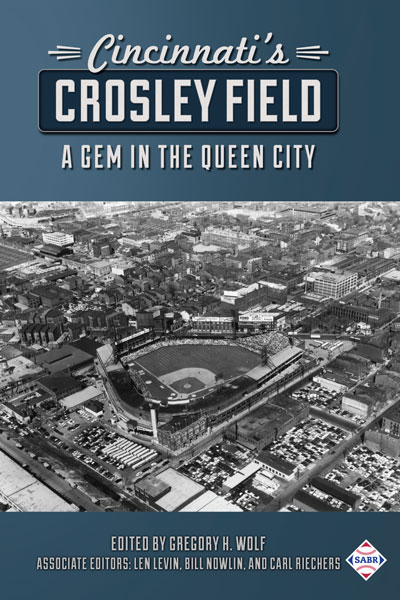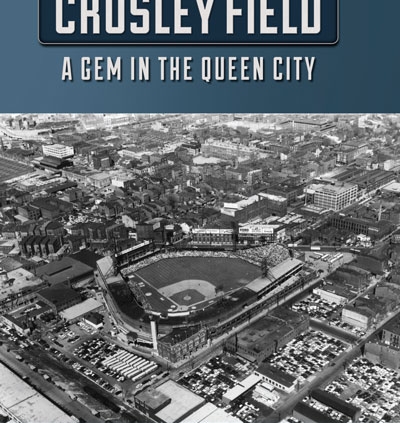Introduction: Cincinnati’s Crosley Field: A Gem in the Queen City
This article was written by Gregory H. Wolf
This article was published in Crosley Field essays
 April 11, 1912, marked a new era in the history of the Cincinnati Reds. On that day the team inaugurated the season by playing its first game at Redland Field, which was renamed Crosley Field in 1934 in honor of the team’s owner, Powel Crosley. The new steel and concrete ballpark was located at the site of its predecessor, the outdated wooden Palace of the Fans at the intersection of Findlay Street and Western Avenue. For almost six decades, Crosley Field beckoned like a shining gem surrounded by warehouses and industrial complexes in the Queensgate neighborhood of the Queen City. The Reds closed the book on Crosley Field on June 24, 1970, and moved into Riverfront Stadium, a modern all-purpose sports venue that held almost twice as many spectators.
April 11, 1912, marked a new era in the history of the Cincinnati Reds. On that day the team inaugurated the season by playing its first game at Redland Field, which was renamed Crosley Field in 1934 in honor of the team’s owner, Powel Crosley. The new steel and concrete ballpark was located at the site of its predecessor, the outdated wooden Palace of the Fans at the intersection of Findlay Street and Western Avenue. For almost six decades, Crosley Field beckoned like a shining gem surrounded by warehouses and industrial complexes in the Queensgate neighborhood of the Queen City. The Reds closed the book on Crosley Field on June 24, 1970, and moved into Riverfront Stadium, a modern all-purpose sports venue that held almost twice as many spectators.
This book evokes memories of Crosley Field through detailed summaries of more than 85 games played there, and 10 insightful feature essays about the history of the ballpark. It was an arduous task limiting the number of games. Our preliminary list was considerably longer, and had other editors chosen the games, their list might have been substantially different. Some of the games might be considered great, like Ewell Blackwell tossing a no-hitter as part of 16 consecutive winning decisions in 1947; or historical, like the first and last regular-season contests at the ballpark; yet other contests might be remembered for outstanding or milestone accomplishments, such as the first night game played in major-league history (in 1935) or Hank Aaron of the Atlanta Braves collecting his 3,000th hit (in 1970); or fantastic finishes like when the Reds overcame a nine-run deficit to win in extra innings, in 1969. The Reds suffered through their share of heartbreak at Crosley Field, and this volume rekindles those memories, too, such as losing at least a tie for the NL pennant on the last day of the 1964 season.
It would have been easy to create a volume consisting solely of great games by Hall of Famers or All-Stars who played for the Reds, players like Edd Roush, Johnny Bench, and Frank Robinson, or Paul Derringer, Bucky Walters, and Pete Rose; however, we were guided by an overarching principle to present the history of the Reds and Crosley Field through the baseball games played at the ballpark. For us that meant also including games focusing on and showcasing as many different players as possible, some well-known, others less so, from Ernie Lombardi, Johnny Vander Meer, and Jim Maloney to Pat Duncan, Hod Eller, and Tom Sheehan. We’ve also included every World Series game played at Crosley Field, from the four as part of the Reds’ tainted victory against the “Black Sox” in 1919, and six more in 1939-40 as the club captured consecutive pennants and its second championship, to the three losses against the overpowering New York Yankees in 1961.
The 10 feature essays contextualize the ballpark’s history. Included is an in-depth historical sketch of Crosley Field itself and shorter pieces focusing on the some of the unique and defining characteristics of the park, such as its outfield terrace, “Goat Run,” “Laundry,” and its evolving dimensions. Essays on Negro League baseball at Crosley Field, the great flood of 1937, the All-Star ballot-stuffing scandal of 1957, and a reflection on The Long Season, the memoir by Reds player Jim Brosnan, help round out the volume. And as is this editor’s tradition, we end with a stat- and factoid piece for all of the numbers-oriented readers.
Members of the Society for American Baseball Research (SABR) made this book possible. These volunteers are united by a passion for researching and writing about baseball history. I thank all of the authors for their contributions, meticulous research, cooperation through the revising and editing process, and finally their patience. I am impressed with your dedication to preserve baseball history by combing archives, interviewing players, and telling the story of so many exciting games played in, and the history of, Crosley Field.
We had an All-Star editorial team. The second reader, Bill Nowlin, read every submission and always provided prodding questions about content. This is the eighth book we’ve worked on together, and I think he anticipates my questions before I ask them. Carl Riechers was the fact-checker. He verified every statistic and fact in every essay, and offered addition insights, suggestions, and information for authors to consider. The copy editor was Len Levin, who has served in this capacity for all of the SABR books. I am not sure what we would do without his deft touch – he made us all look good. It has been a pleasure to once again work on a book project with such professionals, with whom I corresponded practically every day, and typically more than once.
This book would not have been possible without the generous support of the staff and Board of Directors of SABR, SABR Publications Director Cecilia Tan, and designer Gilly Rosenthol (Rosenthol Design).
A word of gratitude goes to two former Cincinnati Reds players, three-time All-Star catcher Johnny Edwards and Art Shamsky, for providing us with their memories of Crosley Field where they debuted as rookies in 1961 and 1965, respectively. Their perspectives of playing in the park enrich this volume immeasurably.
Special thanks go to the Cincinnati Reds Hall of Fame and Museum presented by Dinsmore for providing every photo for this book. I’d also like express my gratitude to the Reds’ Chris Eckes, Operations Manager/Chief Curator, Reds Hall of Fame and Museum, located at the Great American Ballpark in Cincinnati. He was extremely helpful finding and sending us high-resolution images to use for this book. Thanks also go to Greg Rhodes, Cincinnati Reds Team Historian, for his contributions, support, and advice throughout this project. The Reds’ support of SABR’s nonprofit mission is greatly appreciated.
And finally, I wish to thank my wife, Margaret, and daughter, Gabriela, for their endless patience with my baseball pursuits. They are accustomed to my late evenings and early mornings working on SABR projects. Thankfully they are baseball fans who also attend SABR conventions with me.
We invite you to sit back, relax for a few minutes, and enjoy reading about the some of the great, memorable, and historic games and the exciting history of Crosley Field.
Gregory H. Wolf
May 1, 2018
Related links:


